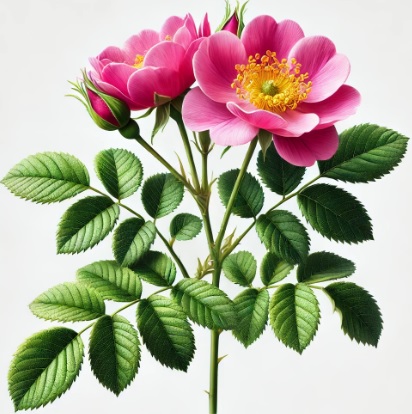Indian rose (Rosa indica and Gulab-Jo-Gul in Sindhi), is a species of rose native to South Asia, particularly India. This plant is valued for its aromatic and colorful flowers, which range from pink to red and white. The Indian rose is versatile and can be cultivated for ornamental purposes as well as for its medicinal and culinary applications.
Botanical Classification:
Kingdom: Plantae
Order: Rosales
Family: Rosaceae
Genus: Rosa
Species: Rosa indica
Plant Characteristics:
Rosa indica is characterized by:
Medium-sized flowers that can be pink, red, or white, with a pleasant and persistent fragrance
Green, glossy, and slightly serrated leaves that provide an elegant contrast to the colorful flowers
A growth habit that can range from compact shrubs to climbing plants, reaching heights of 1 to 2 meters and a similar spread
Resilience and adaptability to various soil types, though it prefers sunny locations and well-drained soil
Chemical Composition and Structure:
The chemical composition of Rosa indica includes:
Essential oils with aromatic compounds such as citronellol, geraniol, and nerol, contributing to its sweet and delicate fragrance
Flavonoids and tannins in the petals and leaves, which offer antioxidant and astringent properties
Anthocyanins and other pigments responsible for the coloration of the flowers, providing additional antioxidant benefits
Uses and Benefits:
Aesthetic: Highly valued for its colorful and fragrant flowers, making it a popular choice for ornamental use in gardens and green spaces.
Cosmetic: Extracts are used in skincare and haircare products for their hydrating, anti-inflammatory, and aromatic properties.
Medicinal: Traditionally used in herbal medicine for its soothing and anti-inflammatory effects, though scientific research on its medicinal properties is limited.
Culinary: Petals can be used in culinary applications, including infusions and desserts, to add a floral and aromatic note.
Applications:
Gardening: Used as an ornamental shrub in flower beds and gardens, ideal for adding color and fragrance to green spaces.
Cosmetics: Extracts incorporated into creams, lotions, shampoos, and conditioners for their beneficial properties and fragrance.
Medicinal: Used in herbal preparations for its potential soothing and anti-inflammatory effects.
Culinary: Fresh or dried petals used in infusions and as an aromatic ingredient in various dishes and preparations.
Environmental and Safety Considerations:
Environmental Impact: Non-invasive and well-suited to a variety of growing environments; contributes to garden biodiversity and supports local pollinators.
Safety: Generally safe to handle and consume; however, individuals with allergies or sensitivities should exercise caution. It is advisable to consult a healthcare provider before using Rosa indica for medicinal purposes.
INCI:
Antioxidant agent. Ingredient that counteracts oxidative stress and prevents cell damage. Free radicals, pathological inflammatory processes, reactive nitrogen species and reactive oxygen species are responsible for the ageing process and many diseases caused by oxidation.
Fragrance. It plays a very important role in the formulation of cosmetic products as it provides the possibility of enhancing, masking or adding fragrance to the final product, increasing its marketability. It is able to create a perceptible pleasant odour, masking a bad smell. The consumer always expects to find a pleasant or distinctive scent in a cosmetic product.
Perfuming. Unlike fragrance, which can also contain slightly less pleasant or characteristic odours, the term perfume indicates only very pleasant fragrances. Used for perfumes and aromatic raw materials.
Flavoring agent. The purpose of this ingredient is to modify the solution to impart a certain flavour. Natural flavouring extracts are rather expensive, so the cosmetic and pharmaceutical industries resort to synthesised substances that have sensory characteristics mostly similar to natural flavourings or are naturally equivalent. This ingredient is isolated through chemical processes or is synthesised from chemicals. It is also referred to as Aroma.
Synonyms:
CAS: 97281-55-5 EC number 306-556-3
![]() Indian rose
Indian rose 

